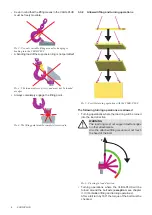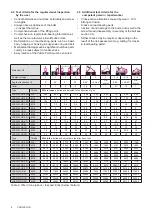
VLBG-PLUS
2
Please read user instruction before initial op-
eration of the bolt-on lifting point VLBG-PLUS.
Make sure that you have comprehended all
subjected matters.
Non observance can lead to serious personal
injuries and material damage and eliminates
warranty.
1 Safety instructions
ATTENTION
Wrong assembled or damaged VLBG-PLUS as
well as improper use can lead to injuries of per-
sons and damage of objects when load drops.
Please inspect all VLBG-PLUS before each use.
• Remove all body parts (fingers, hands, arms, etc.) out
of the hazard area (danger of crushing or squeezing)
during the lifting process.
• The VLBG-PLUS must be used only by authorised and
trained people in adherence to BGR/DGUV regulations
100-500, Chapter 2.8 and, outside Germany, when
observing the relevant specific national regulations.
• Do not exceed the working load limit (WLL) indicated
on the lifting point.
• VLBG-PLUS must be rotatable in the screwed tight
status through 360 °.
• No technical alterations must be implemented on the
VLBG-PLUS.
• No people may stay in the danger zone.
• Jerky lifting (strong impacts) should be prevented.
• Always ensure a stable position of the load when lifting.
Swinging must be prevented.
• Damaged or worn VLBG-PLUS must never be utilised.
2 Intended use
• VLBG-PLUS must only be used for the assembly of
the load or at load accepting means
• Their usage is intended to be used as lifting means.
• The VLBG-PLUS can also be used as lashing points
for the fixture of lashing means.
• The VLBG-PLUS must only be used in the here
described usage purpose.
3 Assembly- and instruction manual
3.1 General information
• Effects of temperature:
Due to the DIN/EN bolts that are used in the VLBG-PLUS,
the working load limit must be reduced accordingly:
-40 °C to 100 °C ––> no reduction
(-40 °F to 212 °F)
100 °C to 200 °C minus 15 % (212 °F to 392 °F)
200 °C to 250 °C minus 20 % (392 °F to 482 °F)
250 °C to 350 °C minus 25 % (482 °F to 662 °F)
Temperatures above 350 °C (662 °F) are not
permitted.
Please observe the maximum usage temperature of
the supplied nuts (optionally):
• Clamping nuts according to DIN EN ISO 7042
(DIN 980) must only be used up to +150 °C at the
max (302 °F).
• Collar nuts according to DIN 6331 can be used
up to +300 °C. Please note also the reduction
factors (572 °F).
• RUD-Lifting points must not be used under chemical in-
fluences such as acids, alkaline solutions and vapours
e.g. in pickling baths or hot dip galvanising plants. If
this cannot avoided, please contact the manufacturer
indicating the concentration, period of penetration and
temperature of use.
• The places where the lifting points are fixed should be
marked with colour.
• VLBG-PLUS lifting points from RUD are supplied with a
crack test inspected hexagon bolt (length up to Lmax,
see table 3).
M8 - M24: ICE-Bolt
M27 - M48: 10.9 bolt
ATTENTION
Use only the appropriate strength class of bolt, for
each specific size. For sizes M8-M24, only original
RUD-ICE-Bolt must be used.
• Original bolts (ICE bolt and 10.9 bolts) are available
as a spare part from RUD.
• When using 10.9 bolts of the size M27-M48 from
other suppliers, make sure that they have been 100 %
inspected in regards of cracks. A written confirmation
of the absence of cracks must be added to the doc-
umentation.
The middle notch toughness at the lowest approved
use temperature must be at least 36 J. This is required
for the test principles for GS OA 15-04 lifting points.
HINT
The dismantling / assembling for the exchange
or inspecting of the bolt may only be executed
by a competent person (compare with Section
3.4 Dismantling / Assembling the RUD bolt).
•
Versions
• RUD supplies the Vario length complete with a
washer and crack-detected nut corresponding to
DIN EN ISO 7042 (DIN 980) or will be supplied with
a crack inspected collar nut acc. to DIN 6331.
• If the VLBG-PLUS is used exclusively for lashing, the
value of the working load limit can be doubled.
LC = permissible lashing capacity = 2 x WLL
HINT
If the VLBG-PLUS is or was used as a lashing
point, it must not be used for lifting later on!

























